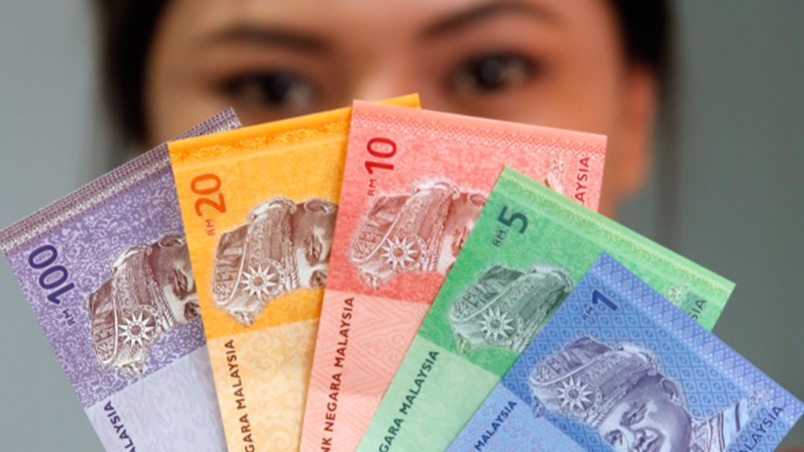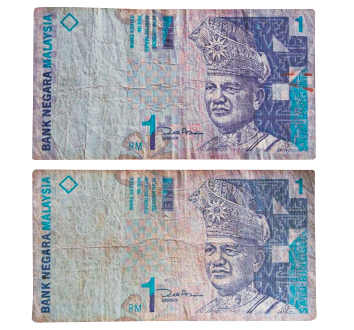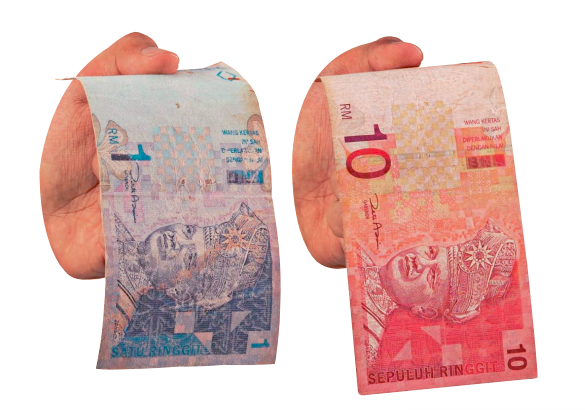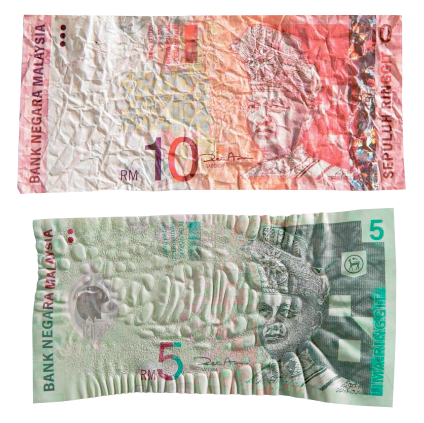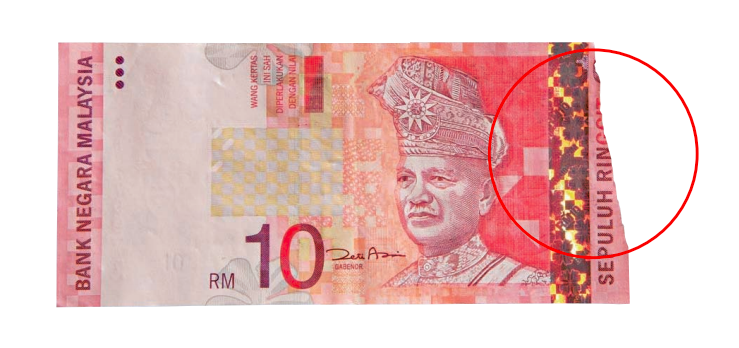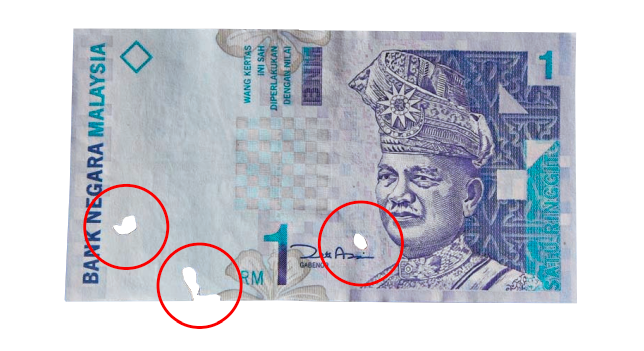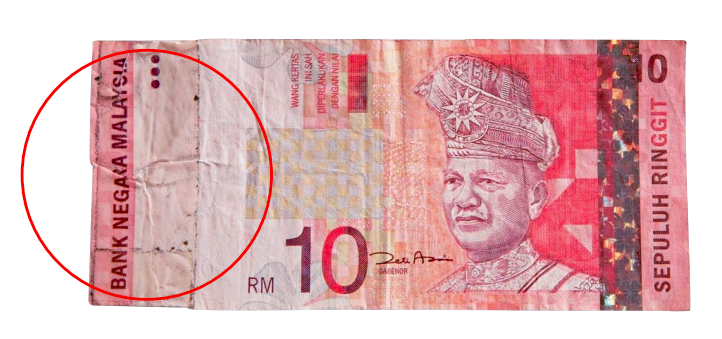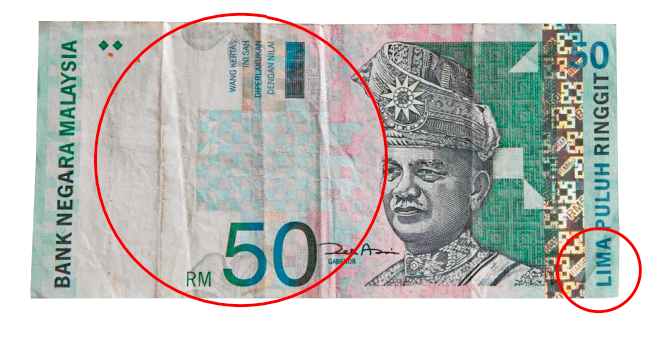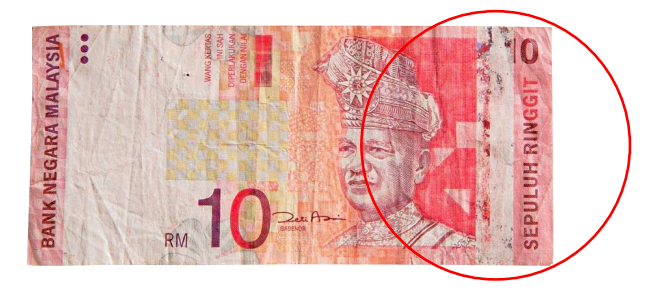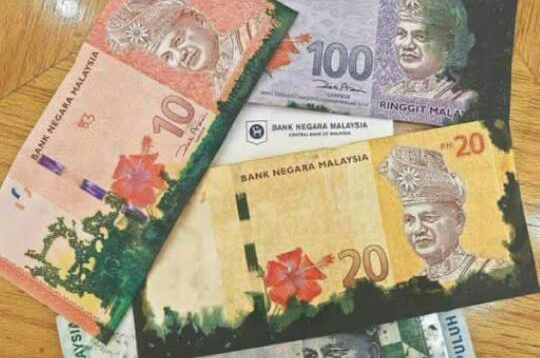If Your Malaysian Banknotes Have Any Of These Defects, You Should Get Them Exchanged
Open your purse or wallet and check all your cash now.
Banknotes deteriorate over time
Given how cash gets around, banknotes are subjected to harsh treatments at times, so, it's not unusual for us to receive banknotes that are no longer in perfect condition. Some may just be dirty or worse, torn and fixed using a cellophane tape.
All we want to do is perhaps quickly pass these imperfect banknotes on to another person in the next cash transaction.
However, did you know that some of these banknotes are not supposed to remain in circulation?
Bank Negara Malaysia (BNM) has been mandated to ensure that monies circulating in the market must be maintained at the desired level. Monies that fall below the standard set by BNM are called as 'unfit currency', which means that the banknote or coin has one or more characteristics which render it unsuitable to be kept in circulation.
There's also a practical reason as to why monies must be kept in good condition for circulation as they can be easily and reliably checked for genuineness, especially since there have been reports of counterfeit Malaysian monies these days.
A banknote that is fit for circulation must:
2. Be free from holes, tears, tape or missing banknote portion
3. Have uniform brightness and is free from excessive soiling
4. Be free from ink wear, particularly on the portrait of the Seri Paduka Baginda Yang di-Pertuan Agong
5. Be free from defacing
There is also a guideline on how to identify Malaysian banknotes that are unfit for circulation:
The information below was obtained from Bank Negara Malaysia's 'Guidelines On Quality Standards For Malaysian Currency' document.
1. Soiling
Soiled banknotes are those with general or localised spread of dirt or liquid on the surface of the banknote.
2. Limpness
Banknotes with very little stiffness from excessive folding which led to the breakdown of the structure and limpness of the banknotes.
3. Crumpled/Shrinkage
Banknotes with multiple random folds or heavy creases across the entire banknote that strongly affect the visual appearance of the banknote, including the shrinkage for the plastic-like polymer banknotes due to exposure to excessive heat.
4. Defaced
Banknotes containing words, signs, symbols, and drawings inscribed deliberately on the surface.
5. Ink wear
Banknotes with fading ink, in which part or whole of the banknote that have its ink wearing off, especially when it has been washed or subjected to abrasive chemical agent.
6. Tears
Banknotes with tears of any size or direction of more than 5mm on any part of the note.
7. Holes
Banknotes with signs of wear such as holes. Do note that staple and pinholes are still acceptable but banknotes exhibiting at least one visible hole that is greater than 5mm are no longer fit for circulation.
8. Repairs
Banknotes in which parts of the same banknote are joined together by tape or glue.
9. Corner folds
Banknotes with permanent and irreparable corner folds leading to a reduction in length of more than 5mm or a reduction in width of more than 5mm.
10. Burnt/Termite infestation
Banknotes that are burnt or infested by termites of any size or direction.
11. Composed banknote
Banknotes with composition of two or more different banknotes using tape to create a single banknote .
12. Missing security feature
Banknotes with loss of a security feature, such as the holographic design LEAD (Longlasting Economical Anticopy Device) strip on a banknote.
You may come across banknotes in bad condition(s) but there's one kind that you should never accept - those that are stained with ink
This is because banknotes stained with ink may could have been stolen from an automated teller machine (ATM).
In the event of an attempted or actual robbery, the ink-stain technology installed within ATMs will be activated to release indelible ink that will stain banknotes, making it no longer fit for further use.
Ever since this technology was adopted, all financial institutions have been instructed by BNM to not accept such banknotes and deposit machines have also been programmed to detect and reject them.
These banknotes are not fit for circulation and and it's possible that they cannot be replaced for value.
"Bank Negara Malaysia (BNM) is the sole authority to issue currency notes in Malaysia and has the absolute discretion to refund the value of any lost, stolen or imperfect banknote that has been tampered with or defaced," BNM stated in its guideline for dye-stained banknotes.
The public should make police report and provide information if they come across any ink-stained banknotes transaction.
What can do you if you own any of these banknotes that are not fit for circulation?
You could still exchange banknotes that have been defaced, mutilated, or damaged. Just head over to any commercial banks or Bank Negara Malaysia branches and get the the unfit currency replaced.
Members of the public can get more information by contacting BNM's Currency Management and Operations Department by calling +603-26988044 ext. 7284/7307/8252/8278, or contacting BNMTELELINK by calling 1-300-88-5465 or sending an email [email protected].
Have you ever exchanged an unfit currency? Share with us your experience in the comment section below.

